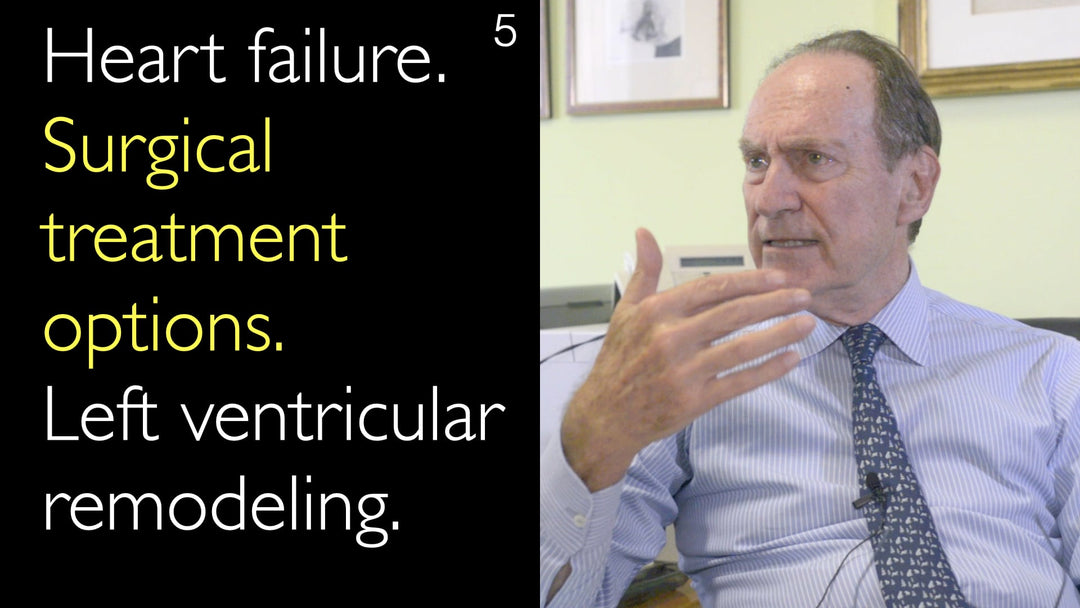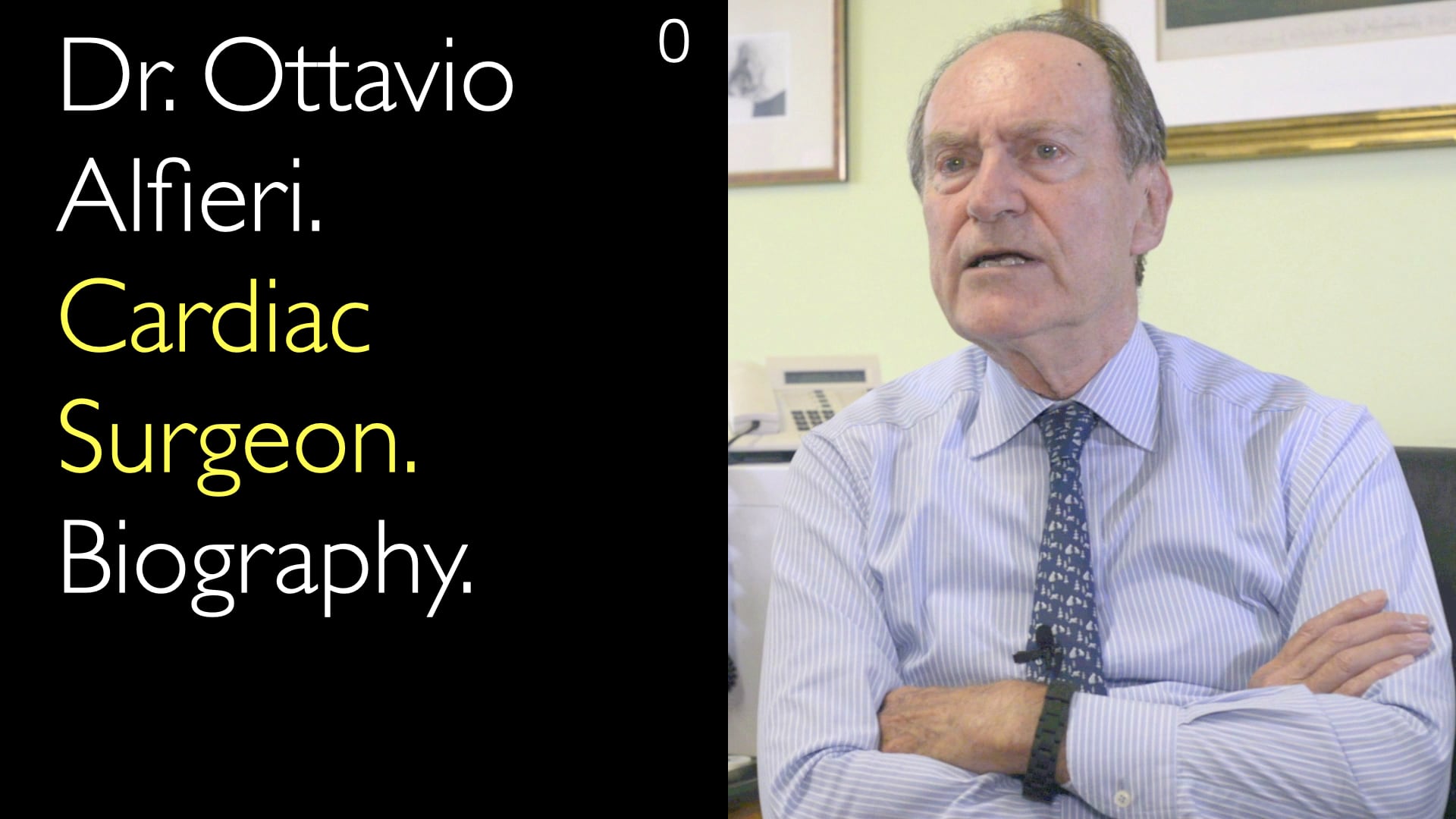ד"ר אוטאביו אלפיירי, MD, מומחה מוביל בכירורגיית לב, דן באפשרויות טיפול כירורגי מתקדמות לאי-ספיקת לב, תוך התמקדות בעיצוב מחדש של החדר השמאלי. מבחינה היסטורית, השתלת לב הייתה האופציה העיקרית לאי-ספיקת לב סופנית, אך טכניקות כירורגיות חדשות מציעות כיום חלופות להיפוך או האטה של עיצוב מחדש של החדר השמאלי. ד"ר אוטאביו אלפיירי, MD מסביר את החשיבות של התייחסות למרכיבים פתופיזיולוגיים כגון קרדיומיופתיה איסכמית, הפרעות קצב ואי-ספיקה מיטרלית. הוא מדגיש את היתרונות של שחזור כירורגי של החדר השמאלי, שיכול לשפר את תפקוד הלב ואת איכות החיים. הדיון גם מדגיש את הערך של גישה רב-מקצועית בהתאמת טיפולים לצרכים האישיים של המטופל.
אפשרויות כירורגיות מתקדמות לאי-ספיקת לב קונגסטיבית ולשינוי המבני של החדר השמאלי
קפיצה לפרק
- הבנת אי-ספיקת לב ושינוי המבני של החדר השמאלי
- יתרונות השיקום הכירורגי של החדר השמאלי
- טיפול באי-ספיקה מיטרלית ובהפרעות קצב
- גישות כירורגיות היברידיות לאי-ספיקת לב
- תפקיד הצוות הרב-מקצועי לטיפול בלב
- תמליל מלא
הבנת אי-ספיקת לב ושינוי המבני של החדר השמאלי
אי-ספיקת לב קונגסטיבית כוללת תהליך מחלה מורכב, הכולל שינוי מבני של החדר השמאלי. ד"ר אוטאביו אלפיירי, MD, מסביר כי אי-ספיקת לב יכולה לנבוע מסיבות שונות, כגון קרדיומיופתיה אידיופתית וקרדיומיופתיה איסכמית, הפוגעת בכ-שני שליש מחולי אי-ספיקת הלב. מצבים אלה מובילים להתכווצות לקויה של הלב, לעיתים קרובות עקב איסכמיה, תרדמת שריר הלב (myocardial hibernation) או הלם לב (stunning). טיפול במרכיבים פתופיזיולוגיים אלה חיוני לטיפול יעיל באי-ספיקת לב.
יתרונות השיקום הכירורגי של החדר השמאלי
שיקום כירורגי של החדר השמאלי מציע יתרונות משמעותיים לחולים עם אי-ספיקת לב. ד"ר אוטאביו אלפיירי, MD, מדגיש כי הליך זה מקטין את גודל החדר השמאלי ומחזיר את צורתו האליפטית הפיזיולוגית, משפר את כושר ההתכווצות ומבטל חוסר תיאום. על ידי כריתה של מוקדים הגורמים להפרעות קצב, הניתוח גם מטפל בהפרעות קצב ממאירות, משפר את תפקוד הלב הכללי ואת איכות חיי החולה.
טיפול באי-ספיקה מיטרלית ובהפרעות קצב
אי-ספיקה מיטרלית והפרעות קצב, כגון פרפור פרוזדורים, הם תורמים שכיחים לאי-ספיקת לב. ד"ר אוטאביו אלפיירי, MD, מציין כי התערבויות כירורגיות יכולות לתקן בעיות במסתם המיטרלי ולבצע הליכי צריבה (ablation) כדי לחסל פרפור פרוזדורים. טיפולים אלה, בשילוב עם רה-וסקולריזציה, מטפלים בסיבות הבסיסיות לתפקוד לקוי של החדר השמאלי, כגון איסכמיה ותרדמת שריר הלב.
גישות כירורגיות היברידיות לאי-ספיקת לב
ד"ר אלפיירי מתאר גישות כירורגיות היברידיות המשלבות מספר הליכים בניתוח אחד. לדוגמה, שיקום החדר השמאלי יכול להתבצע alongside תיקון המסתם המיטרלי, צריבה של פרפור פרוזדורים, וניתוח מעקפים כליליים. לחלופין, גישה היברידית עשויה לכלול שיקום כירורגי עם התערבויות perkutaneous, כגון השתלת סטנט כלילי או צריבה של פרפור פרוזדורים, המותאמות לסיכון הכירורגי ולפרופיל הקליני של החולה.
תפקיד הצוות הרב-מקצועי לטיפול בלב
צוות רב-מקצועי לטיפול בלב הוא חיוני בטיפול באי-ספיקת לב, כפי שמודגש על ידי ד"ר אלפיירי. גישת צוות זו מבטיחה קבלת החלטות מקיפה וביצוע של הליכים מורכבים, תוך מעורבות מומחים מתחומים שונים. באמצעות שיתוף פעולה, צוות הלב יכול להציע תוכניות טיפול מותאמות אישית המשפרות את התוצאות עבור חולים עם אי-ספיקת לב קונגסטיבית ושינוי מבני של החדר השמאלי.
תמליל מלא
ד"ר אנטון טיטוב, MD: אז בוא נדון באפשרויות הטיפול הכירורגי באי-ספיקת לב קונגסטיבית. יש תהליך מחלה שמתרחש באי-ספיקת לב קונגסטיבית. הוא נקרא שינוי מבני של החדר השמאלי (left ventricular remodeling). השתלת לב הייתה historically האפשרות היחידה לאי-ספיקת לב קונגסטיבית ולאי-ספיקת לב קונגסטיבית בשלב סופי. אבל עכשיו קיימות טכניקות כירורגיות חדשות כדי להפוך את השינוי המבני של החדר השמאלי או לפחות להאט אותו באי-ספיקת לב קונגסטיבית. האם תוכל בבקשה לדון באפשרויות הטיפול הכירורגי לחולים עם אי-ספיקת לב קונגסטיבית today?
ד"ר אוטאביו אלפיירי, MD: once you have patients with congestive heart failure, you have to consider the possible pathophysiological components of heart failure. For instance, you can have idiopathic cardiomyopathy, when the heart doesn't contract properly. This is one type of congestive heart failure. This is not so common compared with ischemic cardiomyopathy. Ischemic cardiomyopathy affects about two-thirds of the patients with heart failure.
The components of heart failure are different. You can have ischemia, you can have a hibernation of the myocardium. You can have a stunning of the myocardium. So the heart doesn't receive enough blood and it reacts by a poor contraction. Then you can have other reasons. For instance, you have a dilatation of the heart ventricle, some areas which are now akinetic, or dyskinetic. These factors can contribute to left ventricular dysfunction.
You can also have arrhythmias, for instance, atrial fibrillation. It contributes significantly to the poor left ventricular function. You can also have malignant arrhythmias, for instance. They contribute to problems in this situation. Obviously, you have to consider all these pathophysiological components. You may have, for instance, a dyskinetic area and dilatation of the left ventricle. You can propose a kind of a surgical restoration of the left ventricle.
This can be very effective because you reduce remarkably the size of the left ventricle. You also achieve the physiological shape of the left ventricle, which is not a ball, but it's an elliptic shape. The shape of the heart ventricle is very important for contraction. By offering this type of operation, so-called surgical restoration of the left ventricle, you will improve the quality of life. You improve the performance of the contractility of the left ventricle.
You will have eliminated dyssynchrony of a contraction of the left ventricle. Also, you can eliminate the malignant arrhythmias because you also resect the foci, which are responsible for the arrhythmia. There are many advantages of this type of operation. In addition, if mitral insufficiency is also present, you can treat the insufficiency of the mitral valve. Mitral regurgitation also contributes to heart failure. You can also eliminate this component of heart failure.
You can also eliminate atrial fibrillation with an ablation procedure. Then you can, of course, take care of that cardiac arrhythmia. You can also revascularize the patient. This will treat the hibernation of the ventricle or ischemia of the left ventricle. They produce this dysfunction of the contraction of the left ventricle. So putting together all these operations, you can really eliminate heart failure.
When heart failure is too advanced, and you have a very, very low ejection fraction, almost the entire ventricle is fibrotic. Then you have options only of heart transplantation or left ventricular assist device or replacement of the heart or an artificial heart. But this, of course, is a more rare situation.
ד"ר אנטון טיטוב, MD: טכניקות כירורגיות אלה הן when you plan a heart failure surgery to stop advancement or to even reverse the left ventricular remodeling. האם אתה עושה זאת בניתוח אחד? או שאתה עושה זאת בניתוחים כירורגיים sequential?
ד"ר אוטאביו אלפיירי, MD: many things you can do during the same surgery. For instance, you can make a restoration of the left ventricle together with correction of mitral insufficiency, ablation of atrial fibrillation, and revascularization of the heart. This is eliminating the problem of hibernation of the myocardium of the left ventricle.
ד"ר אנטון טיטוב, MD: אוקיי, זה מאוד חשוב. אז אתה יכול לעשות את ניתוח הלב ההיברידי. אתה יכול לעשות ניתוח מעקפים כליליים ובו זמנית אתה יכול לפתור את הבעיה המסתמית. וזה מטפל באי-ספיקת הלב, בשינוי המבני של החדר השמאלי.
ד"ר אוטאביו אלפיירי, MD: you can do both surgical operations together. Or you can use also a hybrid type of approach. For instance, you can do the surgical remodeling of the left ventricle and use, for instance, a percutaneous coronary intervention to solve the ischemia problem of the left ventricle. You can also use, for instance, percutaneous ablation of atrial fibrillation in combination with the surgical left ventricle restoration.
You can really decide the correct intervention according to the surgical risk of the patient, the clinical profile, and the age of the patient. So you can try to offer the best treatment for the patient.
ד"ר אנטון טיטוב, MD: אז זה גם חשוב להדגיש את הגישה הרב-מקצועית.
ד"ר אוטאביו אלפיירי, MD: exactly! What you have noticed from what I said is that there are different specialties interacting in this treatment. This is a typical example of the heart team. It is very important not only in the decision-making but also in performing the procedures.





